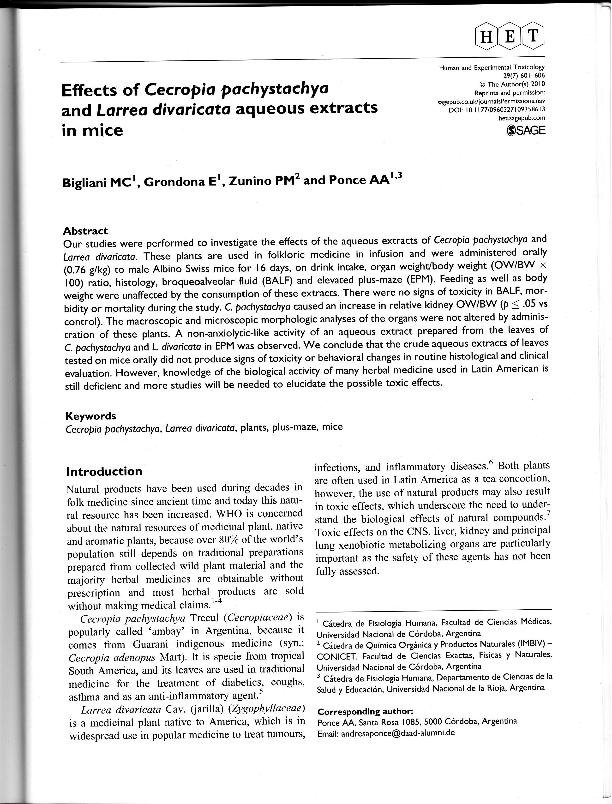Artículo
Effects of Cecropia pachystachya and Larrea divaricata aqueous extracts in mice
Fecha de publicación:
07/2010
Editorial:
Sage Publications Ltd
Revista:
Human and Experimental Toxicoloxy
ISSN:
0960-3271
e-ISSN:
1477-0903
Idioma:
Inglés
Tipo de recurso:
Artículo publicado
Clasificación temática:
Resumen
Our studies were performed to investigate the effects of the aqueous extracts of Cecropia pachystachya and Larrea divaricata. These plants are used in folkloric medicine in infusion and were administered orally (0.76 g/kg) to male Albino Swiss mice for 16 days, on drink intake, organ weight/body weight (OW/BW × 100) ratio, histology, broqueoalveolar fluid (BALF) and elevated plus-maze (EPM). Feeding as well as body weight were unaffected by the consumption of these extracts. There were no signs of toxicity in BALF, morbidity or mortality during the study. C. pachystachya caused an increase in relative kidney OW/BW (p ≤.05 vs control). The macroscopic and microscopic morphologic analyses of the organs were not altered by administration of these plants. A non-anxiolytic-like activity of an aqueous extract prepared from the leaves of C. pachystachya and L. divaricata in EPM was observed. We conclude that the crude aqueous extracts of leaves tested on mice orally did not produce signs of toxicity or behavioral changes in routine histological and clinical evaluation. However, knowledge of the biological activity of many herbal medicine used in Latin American is still deficient and more studies will be needed to elucidate the possible toxic effects.
Palabras clave:
CECROPIA PACHYSTACHYA
,
LARREA DIVARICATA
,
MICE
,
PLANTS
,
PLUS-MAZE
Archivos asociados
Licencia
Identificadores
Colecciones
Articulos(IMBIV)
Articulos de INST.MULTIDISCIPL.DE BIOLOGIA VEGETAL (P)
Articulos de INST.MULTIDISCIPL.DE BIOLOGIA VEGETAL (P)
Citación
Bigliani, María Celeste; Grondona, Ezequiel; Zunino, María Paula; Ponce, A. A.; Effects of Cecropia pachystachya and Larrea divaricata aqueous extracts in mice; Sage Publications Ltd; Human and Experimental Toxicoloxy; 29; 7; 7-2010; 601-606
Compartir
Altmétricas




